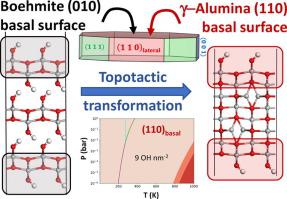Journal of Catalysis ( IF 7.3 ) Pub Date : 2021-11-16 , DOI: 10.1016/j.jcat.2021.11.011 Thomas Pigeon 1, 2 , Céline Chizallet 1 , Pascal Raybaud 1, 2

|
The rational understanding of γ-alumina (γ-Al2O3) supported catalysts requires an ever more improved atomic scale determination of the support’s surface properties. By using density functional theory (DFT) calculations, we show how the structural and energetic surface properties of alumina crystallites intrinsically depend on its synthesis pathway. Considering the case study of the topotactic transformation of boehmite (γ-AlOOH) into γ-Al2O3 taking place during calcination, we propose a methodology to mimic this pathway by reconstructing relevant slabs of boehmite into γ-alumina slabs following 3 steps: dehydration, contraction/translation and Al migration into spinel or non-spinel sites. On the one hand, we confirm the reliability of some earlier , and surface structures determined by standard bulk cleavage approach. Moreover, we find new γ-alumina surfaces harboring Brønsted acid sites (BAS) and Lewis acid sites (LAS) with specific local structures. More strikingly, we find that the basal surface of alumina inherited from the (0 1 0) basal surface of boehmite, exhibits a larger number of isolated µ2-OH groups than the lateral surface. For the lateral (respectively ) orientation, four (respectively three) thermodynamically competing surfaces are identified, including models earlier proposed. These results are induced by finite size and morphology effects during the topotactic transformation of boehmite crystallites. Thanks to a thorough comparative analysis of morphology and nature of BAS and LAS as a function of thermal treatment and water pressure for each surface, we identify coherent chemical families of surfaces across the main crystallographic orientations. These features open the door to a better differentiation of the reactivity of the basal alumina surfaces from the lateral ones.
中文翻译:

通过勃姆石表面的拓扑转化重新审视γ-氧化铝表面模型
对 γ-氧化铝 (γ-Al 2 O 3 ) 负载催化剂的合理理解需要对载体表面性质的原子尺度测定进行更加改进。通过使用密度泛函理论 (DFT) 计算,我们展示了氧化铝微晶的结构和能量表面特性如何本质上取决于其合成途径。考虑到勃姆石 (γ-AlOOH) 向 γ-Al 2 O 3拓扑转化的案例研究在煅烧过程中,我们提出了一种模拟该途径的方法,通过以下 3 个步骤将相关的勃姆石板重建为 γ-氧化铝板:脱水、收缩/平移和铝迁移到尖晶石或非尖晶石位点。一方面,我们确认了一些较早的可靠性, 和 由标准体裂解方法确定的表面结构。此外,我们发现新的γ-氧化铝表面含有具有特定局部结构的布朗斯台德酸位点(BAS)和路易斯酸位点(LAS)。更引人注目的是,我们发现基础氧化铝的表面继承自勃姆石的 (0 1 0) 基面,表现出比横向更多的孤立的 µ 2 -OH 基团表面。对于横向 (分别 ) 方向,确定了四个(分别为三个)热力学竞争表面,包括早先提出的模型。这些结果是由勃姆石微晶拓扑转化过程中的有限尺寸和形态效应引起的。由于对 BAS 和 LAS 的形态和性质作为每个表面的热处理和水压的函数进行了彻底的比较分析,我们确定了跨主要晶体取向的表面的连贯化学家族。这些特征为更好地区分基底氧化铝表面与侧面表面的反应性打开了大门。


























 京公网安备 11010802027423号
京公网安备 11010802027423号